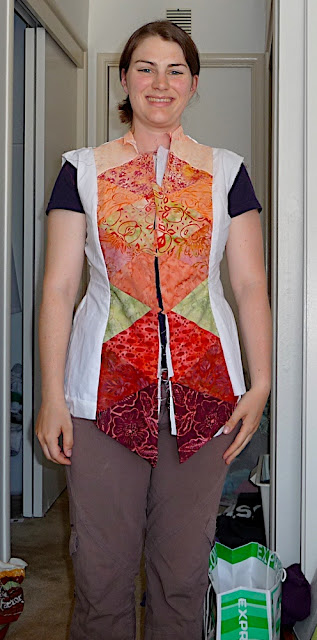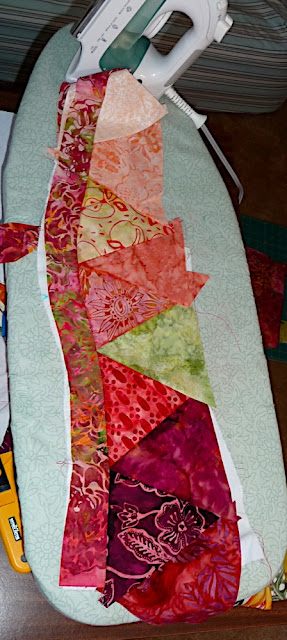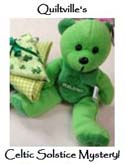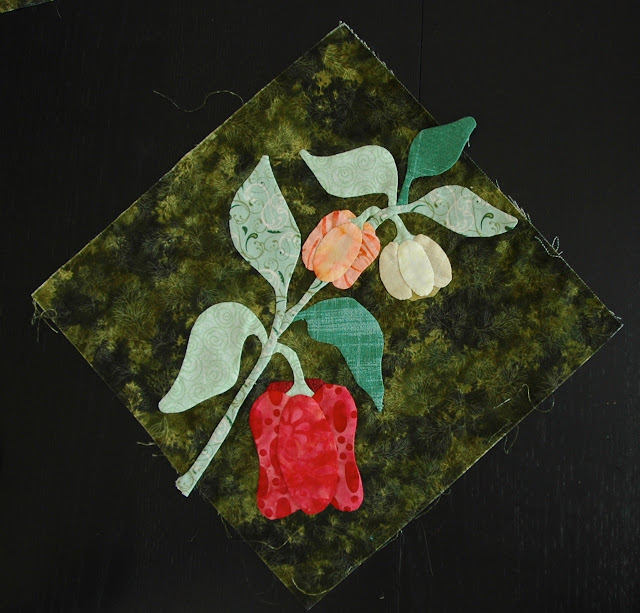Okay, camera has been repaired so now I can share with you the full (and finally complete) story of my pieced jacket.
It all started back at PIQF 2011. I saw a jacket pattern, thought it looked nice, and said "hey, I'll make a jacket for my mom!"
 |
| The original pattern. Looks cool, right? (Also nothing like my final jacket!) |
Together my mom and I chose this loooooovely color palate. As a side note, because the original jacket was really baggy, I ended up with probably enough fabric for an entire quilt.
Unfortunately when I made the muslin foundation, we determined that the jacket was not stylish enough for her.
 |
| Looks like a lab coat! |
So we went out and bought a stylish coat pattern!
Here was my first attempt at a muslin foundation. You can see all the proportions are off, but at least it looks more fitted than the original jacket design.
For some reason I thought it would be a great idea to use the piecing design from the original pattern (which as you can see has nice straight lines and not fitted curves) and try to morph it onto this other jacket.
The original design calls for lines of equilateral triangles with strips of fabric between them. So I attempted to do that on the curvy pieces of my jacket.
If I recall, I marked the seam line, then marked about 2" in from that (for those fabric strips, then sewed the triangles to the muslin so that their points all met the seam line. It was basically foundation piecing. You can see that I started with uniform size and shaped triangles, but in the end they were all different sizes and shapes, based on the contours of the jacket.
 |
| First panels pieced! Notice how much longer the jacket is here than in the final version. |
 |
| Here you can see me drawing out the design onto the muslin, which ended up being a foundation. |
For a while I was foundation piecing without realizing that I was doing it, which led to a lot of squinting to see if lines matched up and general headaches. Once I realized it was basic foundation piecing, things went much more smoothly.
 |
| Another panel complete! |
Then I ran into another big headache: Trying to stitch on those fabric strips. It involved curved piecing, which I had never done before and didn't know how to do.
First I tried to just cut a 2" and stitch it down, which led to all kinds of rippling.
I finally jut stitched on a giant piece and trimmed it down later. It was hands down the hardest part of this process and took FOREVER.
 |
| Front panels complete! |
Then came the back panel. By now I was feeling a lot more flexible about following the original pattern (and having realized that it was REALLY TOUGH to follow) so I went with the foundation piecing approach and traced out my design in advance.
Except, of course, you can see this would require Y seam if directly foundation pieced. So I had to make diagonal strips and line them up. Again, this complicated things probably more than they needed to be and involved a lot of tedious eyeballing.
 |
| All stitched down! |
I don't even know what I was thinking in the photos below. Some weird and time-consuming made-up method for curved piecing. Oy.
 |
| back strips attached! |
So, well over a year ago, I finished everything in the body except the sleeves, and by this point was so mad at curved piecing that I stopped and put the whole thing away.
Last week I picked it up again with a fresh eye. Taking into account my past grievances, I decided for the sleeve to just do diamonds of a uniform size and shape: 3.5".
Then came so pretty pathetic attempts to figure out how to add seam allowance. I mean, really. I am sure this is super basic geometry but heck if I remembered it.
So without seam allowances, the finished diamond was 3.5" on each side. So naturally I cut a diamond that was 4" on each side. As you can see in the photo below, it was too small.
Then I tried to look up sizing online but couldn't find anything explicitly spelling out how to figure out your cut size based on your finished size.
So finally, in desperation, I traced out my 3.5" diamond and manually traced the seam allowance on, then measured to see what size that was.
And if you were wondering, the answer is weirdly simple. Cut a strip of fabric whose height is your finished diamond side size (so my strip was 3.5" tall) and then lining your ruler up along the 30˚ angle, and cutting a diagonal piece that is also your finished size (3.5" for me). I don't think I explained that so great, but this is about the point where my camera broke, so I don't have any more photos of assembly.
Here's a final shot I took of my color layout plan before I assembled the diamonds.
Okay, so fast forwarding to the finished jacket. The sleeves sent together very nicely and the jacket actually assembled very easily. I will say this about Simplicity: They do a GREAT job of making very easy to follow instructions. I had no clue what I was doing, but they were extremely clear in their instructions and spelled out every last detail.
So here are some beauty shots of the final jacket:
 |
| Side shot. I think the diamonds on the sleeves came out well. The diamonds did not meet up evenly on the underside, but I doubt many will see the underside of the sleeves. |
 |
| The back. Slimming! |
Okay, so what are the lessons learned? First, I should have made my muslin foundation too long. I shortened both the sleeves and hemline up to what I wanted the final length to be, but of course some fabric had to be turned in and I didn't account for that, hence sleeves and length that were a bit too short. Notice the difference in hem length in the original muslin foundation and finished piece in the photos below.
I also shouldn't have used cotton for the lining. Some people I chatted with suggested silk or voile. I guess the cotton was too bulky. Once I added the lining suddenly everything was too darn snug. Grr. Notice in the photo below that the jacket bulges in between buttons and is crinkling near the midsection. You can also see in those photos above how it was much more fitted and slimming in the muslin version. I blame the lining.
Also I have since learned that you should pre-wash muslin because it is very prone to shrinking. Since I didn't prewash my muslin, and ended up sewing it into the jacket, this thing can probably never be washed for fear of it becoming all wrinkly and ruined. Ack!
The good news is, this thing looks better and is pretty comfortable if you wear it unbuttoned!
And now it's all done! Phew! If I ever do a jacket again, I'm going to use the fabrics recommended in the pattern and not try to do my own thing. I will definitely use Simplicity again for clothing patterns as they are very straightforward and I think I need things spelled out for me for a few more projects.























